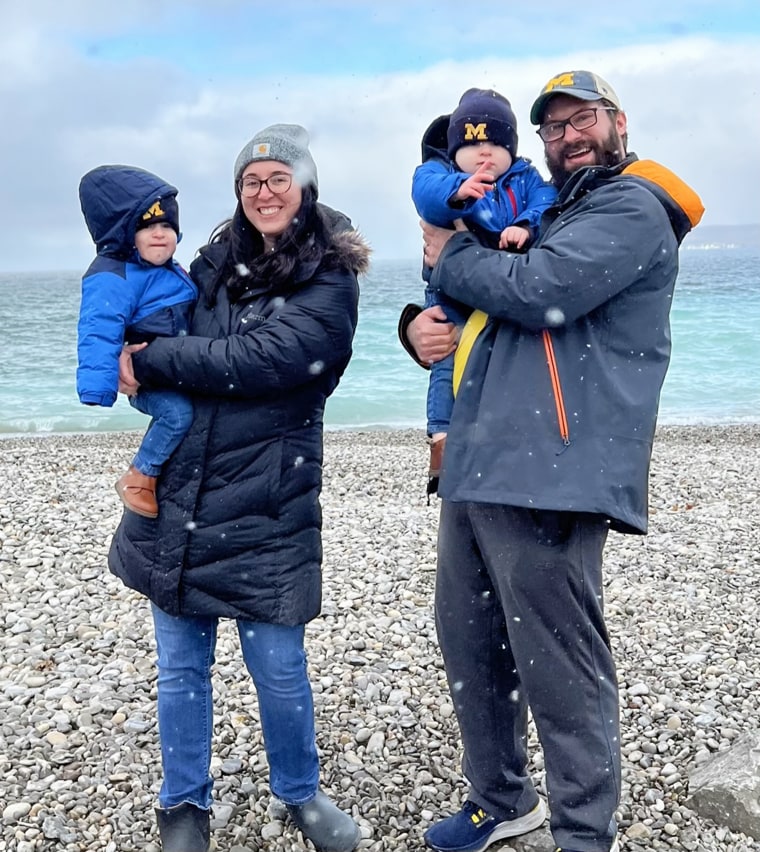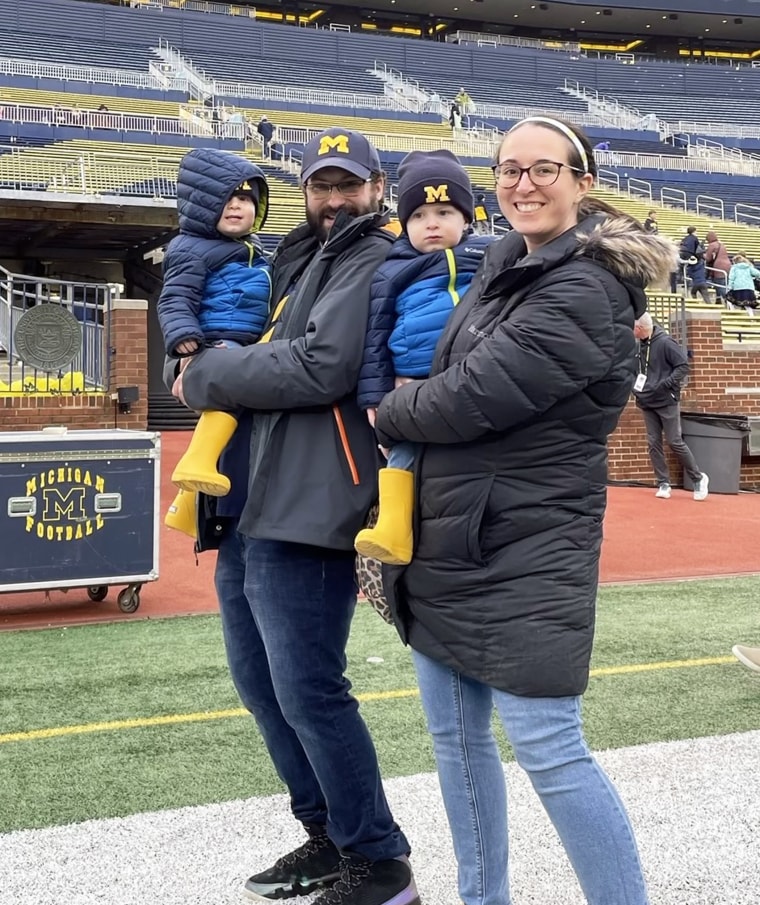In 2018, Melissa Bradley, then 28, and her husband wanted to start a family. But she ran into a problem — sex hurt. At first, she wondered if it was her body adjusting to going off birth control. Then she began having lengthy periods. She visited her OB-GYN to make sure everything was OK.
“They did a transvaginal ultrasound, and they were like, ‘Oh you have a cyst. You probably have (polycystic ovary syndrome),’” Bradley, 32, from Northville, Michigan, tells TODAY.com.
Because of its size, doctors wanted to remove it to prevent ovarian torsion, which occurs when the organ twists painfully. Before the surgery was over, the doctor realized what the cyst was.
“My surgeon came out and spoke to my husband and my parents and said, ‘You know, this is cancer,’” she says.
Bradley had stage 2 ovarian cancer.
Painful sex, long periods, feeling full
In 2018, Bradley stopped taking birth control because she and her husband wanted to start a family. Soon after, she noticed intercourse felt painful.
“It was excruciating,” she says.
Her periods became longer, too.

“I didn’t know if that was my body changing, coming off of birth control,” she says.
During meals, Bradley also started to feel that she was getting full quickly and started eating less. And she found herself running to the bathroom frequently because she had to pee.
About two months after stopping birth control, she visited her doctor to make sure she was healthy enough to get pregnant. That’s when the ultrasound found the cyst. The doctor also did blood tests to see if there was a marker associated with ovarian cancer, which some ovarian cancers have. She did not test positive for the marker.
“It came back pretty much in the normal range, maybe on the higher end,” she says. “They were like, ‘We’re 95% sure you don’t have cancer.’”
But the size of the cyst was concerning to the doctors and they worried it could cause her ovary to twist. Her doctor told her if she experienced “extreme pelvic pain,” to visit the emergency room, she recalls. Two days later, that's exactly what happened, so she did.
“I thought I was hallucinating in the middle of the night. I didn’t know if I was awake or asleep, if I was having a nightmare about the pain,” she says.
The ER doctors told Bradley to follow up with her OB-GYN, who recommended she consult a gynecological oncologist, who then advised she get surgery to remove the cyst. Before the doctor even finished the procedure in May 2019, they knew it was an ovarian cancer, later determined to be a stage 2 granulosa cell carcinoma.
“Mine was still in my pelvis but spread to the pelvic floor, not just my ovary,” she says.
Prior to her surgery, she'd spoken with her doctor about what the procedure could mean for her fertility.
“My top priority was being able to have kids,” she says. “The vast majority of women with ovarian cancer have a radical hysterectomy. ... Luckily, I wasn’t as far advanced in my (cancer stage), and we were able to do fertility-sparing surgery.”
Her doctor removed the right ovary, which was “crushed by the tumor,” and the right fallopian tube, Bradley explains. She had a complication from surgery, a nerve injury that made her unable to move her left leg. She had to re-learn how to walk with physical therapy. She also began IVF so doctors could retrieve her eggs before she began chemotherapy in fall 2019.
“With my subset of cancer, which is very, very rare, they didn’t have any documented successful IVF transfers,” she says. “It was devastating each time I had an egg retrieval to have a painful procedure … and to have the news that, ‘Oh, we only got one,’ or ‘We only got a couple.’”
After egg retrieval, Bradley underwent six rounds of chemotherapy from September 2019 to January 2020.
“I don’t think anyone enjoys (chemo), but I feel very lucky,” she says. “I did not throw up during chemo. I was really adamant about taking my nausea meds and drinking a lot of water.”
At times, she experienced “complete exhaustion.”
“I remember one 36-hour period where I slept for 28 hours,” she says. “I’d wake up and my husband’s just doing different things around me, but I was sleeping through the lights, sleeping through vacuuming.”
Ovarian cancer
“Ovarian cancer is the second most common gynecological cancer,” Dr. Zaid Al-Wahab, a gynecological oncologist at Corewell Hospital in Royal Oak, Michigan, who treated Bradley, tells TODAY.com. “It is the most common cause of death from gynecological cancers.”
The reason ovarian cancer is so deadly is because it’s most often diagnosed in advance stages, he says. About 80% of the cases are found in stage 3 or 4. It’s challenging to find early because stage 1 and 2 ovarian cancer have few, if any, symptoms.
“A lot of the time there are no symptoms, and even when it’s stage 3 or 4, symptoms are very vague,” Al-Wahab says, adding that "there is no screening test for ovarian cancer.”
Symptoms of ovarian cancer can include:
- Bloating
- Change in bowel habits
- Back pain

Risk factors for ovarian cancer remain unclear, though people who have the BRCA mutation are more likely to develop ovarian cancer.
“There’s always this perception that it happens in certain types of patients with the mutation or elderly women, and really if you look at the average age, it is 63,” Al-Wahab says. “It can happen in much younger women so more awareness of ovarian cancer (is needed).”
Starting a family
After finishing chemotherapy, Bradley scheduled her embryo transfer.
“My doctor was a little apprehensive (because) my body just went through so much, and then (I was) trying to get pregnant, but he honored my wishes and knew that it was safe,” she says. “I got started with my reproductive endocrinologist.”
The COVID-19 pandemic started before she underwent her transfer, and it was canceled. By July 2020, she could pick things back up.
“I got pregnant on our first transfer,” she says. “We used two embryos and got two babies, so that was a huge win in everyone’s eyes.”
Bradley developed gestational hypertension and delivered her twin boys about four weeks early. But they were big enough and didn’t need to spend any time in the neonatal intensive care unit. In March they turned 2. Bradley is now pregnant again — this time with a girl.
“This pregnancy has been a lot easier than twins,” she says. “She’s doing well. My biggest complaint is heartburn."
Bradley shares her story to raise awareness of ovarian cancer and the importance of advocating for the kind of care you want. And she wants to encourage people to speak up about symptoms, even if they feel too intimate.
“There is a tendency to shy away from speaking about your reproductive organs and speaking about issues you might feel during sex or abnormal periods. There’s a lot of stigma,” she says. “There really should not be any shame in speaking about what’s happening with your body.”